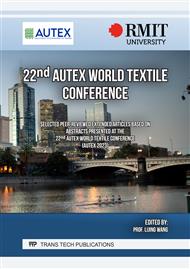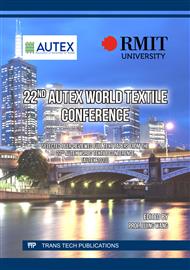[1]
Patel, A., D'Alessandro, M. M., Ireland, K. J., Burel, W. G., Wencil, E. B., & Rasmussen, S. A. (2017). Personal Protective Equipment Supply Chain: Lessons Learned from Recent Public Health Emergency Responses. Health security, 15(3), 244–252
DOI: 10.1089/hs.2016.0129
Google Scholar
[2]
Rondinone, D., Godfrey, A. B., & Khamkar, A. A. (2021). Challenges in the Supply Chain for Personal Protective Equipment (PPE) during Covid-19. Journal of Textile & Apparel Technology & Management (JTATM), 12.
Google Scholar
[3]
WTO Reports World Textiles and Apparel Trade in 2020 https://shenglufashion.com/2021/08/04/wto-reports-world-textiles-and-apparel-trade-in-2020/
Google Scholar
[4]
McMaster, M., Nettleton, C., Tom, C., Xu, B., Cao, C., & Qiao, P. (2020). Risk management: Rethinking fashion supply chain management for multinational corporations in light of the COVID-19 outbreak. Journal of Risk and Financial Management, 13(8), 173.
DOI: 10.3390/jrfm13080173
Google Scholar
[5]
Xu, Z., Elomri, A., Kerbache, L., & El Omri, A. (2020). Impacts of COVID-19 on global supply chains: Facts and perspectives. IEEE Engineering Management Review, 48(3), 153-166.
DOI: 10.1109/emr.2020.3018420
Google Scholar
[6]
Rubashkin, M., Purzycki, T., Coolahan, K., Lee, C., Lurie, D. J., Batorsky, B., ... & He, S. (2023). PPE needs in the United States during the COVID‐19 pandemic: An analysis using the GetUsPPE online platform. Public Health Challenges, 2(1), e65.
DOI: 10.1002/puh2.65
Google Scholar
[7]
Bae, S. Y. (2022). Pandemic and Post-pandemic Fashion Consumer and Business Trends. Visions in Leisure and Business, 24(2), 6.
DOI: 10.25035/visions.24.02.06
Google Scholar
[8]
Beltrami, M., Kim, D., & Rölkens, F. (2019). The state of fashion 2019.
Google Scholar
[9]
Nadvi, K., Thoburn, J. T., Thang, B. T., Ha, N. T. T., Hoa, N. T., Le, D. H., & Armas, E. B. D. (2004). Vietnam in the global garment and textile value chain: impacts on firms and workers. Journal of international development, 16(1), 111-123.
DOI: 10.1002/jid.1066
Google Scholar
[10]
Larue, B. (2020). Labor issues and COVID‐19. Canadian Journal of Agricultural Economics/Revue canadienne d'agroeconomie, 68(2), 231-237.
DOI: 10.1111/cjag.12233
Google Scholar
[11]
Cohen, J., & van der Meulen Rodgers, Y. (2020). Contributing factors to personal protective equipment shortages during the COVID-19 pandemic. Preventive medicine, 141, 106263.
DOI: 10.1016/j.ypmed.2020.106263
Google Scholar
[12]
Moosavi, J., Fathollahi-Fard, A. M., & Dulebenets, M. A. (2022). Supply chain disruption during the COVID-19 pandemic: Recognizing potential disruption management strategies. International Journal of Disaster Risk Reduction, 102983.
DOI: 10.1016/j.ijdrr.2022.102983
Google Scholar
[13]
Huynh, P. H. (2021). Enabling circular business models in the fashion industry: the role of digital innovation. International Journal of Productivity and Performance Management, 71(3), 870-895.
DOI: 10.1108/ijppm-12-2020-0683
Google Scholar
[14]
Shih, W. C. (2020). Global supply chains in a post-pandemic world. Harvard Business Review, 98(5), 82-89.
Google Scholar
[15]
Tseng, M. L., Bui, T. D., Lim, M. K., Fujii, M., & Mishra, U. (2022). Assessing data-driven sustainable supply chain management indicators for the textile industry under industrial disruption and ambidexterity. International Journal of Production Economics, 245, 108401.
DOI: 10.1016/j.ijpe.2021.108401
Google Scholar
[16]
Davenport, Thomas H.; A. Blanton Godfrey and Thomas C. Redman (Aug. 25, 2020). To Fight Pandemics, We Need Better Data. Sloan Management Review. Retrieved September 15, 2020, from https://sloanreview.mit.edu/article/to-fight-pandemics-we-need-better-data/
Google Scholar
[17]
Raj, A., Mukherjee, A. A., de Sousa Jabbour, A. B. L., & Srivastava, S. K. (2022). Supply chain management during and post-COVID-19 pandemic: Mitigation strategies and practical lessons learned. Journal of business research, 142, 1125-1139.
DOI: 10.1016/j.jbusres.2022.01.037
Google Scholar
[18]
Arangdad, S. R., Godfrey, B., Hoque, S. A., Joshi, P., Manoharan, A. P., & Vhanmane, A. (2021). COVID 19: Situation, Action, and Tracking of PPE Demand in the US. Journal of Textile and Apparel, Technology and Management.
Google Scholar



